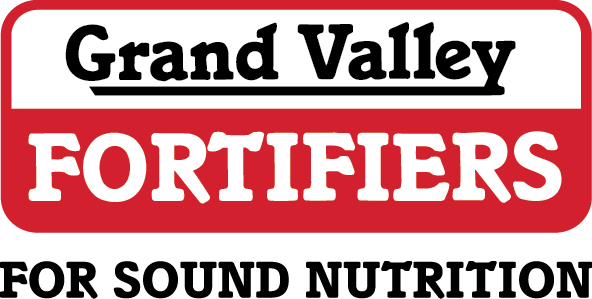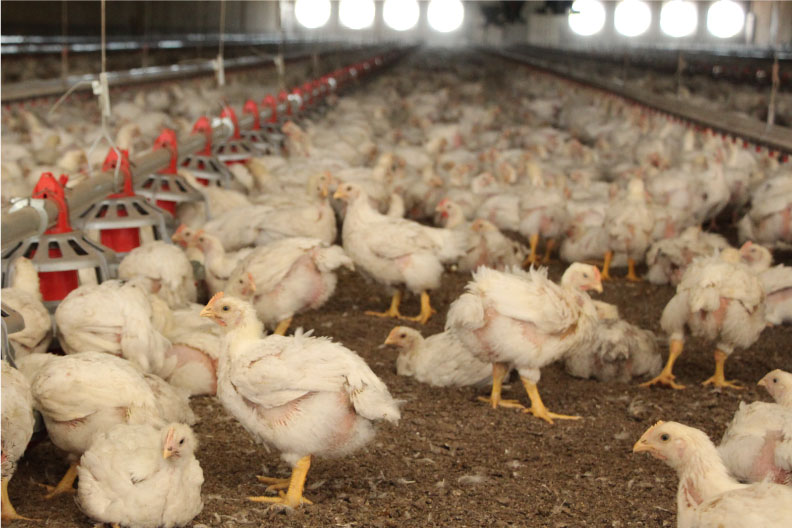By Ryan Snyder
Poultry Production Improvement Specialist
Grand Valley Fortifiers
The variation of the flock can be expressed as uniformity or the coefficient of variation, both of which are used to refer to how similar the weight of individual chickens are to one another in a flock. Uniformity is calculated as a percentage of birds that are within +/- 10% of the average. The larger the number, the more uniform the flock. The Coefficient of Variation (C.V.) is calculated as the standard deviation divided by the average. In the case of the C.V., the larger the number, the less uniform the flock. These measures are more typically used in layer flocks, where the size of the pullet determines when she will start laying eggs. So having all the layers be at the exact same size (highly uniform), allows the barn to come into production more synchronized which benefits the flock. While there is little scientific data measuring the impact of poor uniformity in broilers, there are reported links to increased mortality/culling, increased condemnations, as well as poorer FCR and market weight.
When our poultry team is on-farm collecting body weights, we use a pullet scale that takes individual weights and calculates the uniformity for us automatically. We gather a large group of birds (about 100) in a temporary fence along the wall and start weighing individually. It’ll require at least 40 individual weights to start to get an idea what the uniformity is. Sometimes, it can take as many as 80 birds to get a realistic uniformity measure. I typically have seen that a good target for uniformity at any given age is about 60%. I’ll often see 50%, but that’s not problematic. When we get below 40%, I start to have concerns, and begin looking for areas for improvement. Some of the best results I’ve come across have been in the 70-80%, but this is not common. As the birds get older, the uniformity can improve, because the 10% range has become larger and larger around the higher average weight.
So what are some of the causes of poor uniformity?
Barn management can be a starting point. Most of uniformity problems occur early on in the flock. Brooding conditions are extremely important during the first few days. At this young age, the chick is considered poikilothermic, meaning their body temperature is dependant on their environment. A chilled or overheated chick will need to use energy to maintain homeostasis rather than for growth and development. This growth and development may vary based on the chick’s health and strength and could vary throughout the barn depending on the heating and ventilation equipment. The barn environment needs to have the right range for chicks to find the comfort zone. During the first 10 days, a chick increases it’s bodyweight by up to 20% per day, compared to only 4% per day when the bird is between 30-40 days old.
Access to water and feed, temperature, and lighting all stimulate chicks to get off to a great start. However, any deficiencies in these areas may cause a proportion of chicks to become distracted or lost which will result in a slightly delayed start in their development. Tolerance to gases such as CO2 and ammonia will differ between chicks in a population, so ventilation that removes such gases will ensure the entire flock remained unaffected. Brooding management has become a hot topic in the last several years, because it has been shown that a great start leads to an amazing finish.
Assuming barn management is ideal, there are a few other places to look for deficiencies in uniformity. Broiler breeder status, breeder flock age, hatchery management, chick quality, breed, and sexed versus mixed-sex flocks all are key components of a broiler flock’s uniformity. Getting a delivery of chicks from a single breeder flock has given amazing uniformity results. It is very possible to for a load of chicks to show up and they are already nonuniform. It’s inevitable, but ensuring the best brooding management practices are used, we can ensure the variability doesn’t get any worse.
Nutrition is, of course, a major component as it is our primary input for growth and development. There is research showing that deficiency of lysine and other amino acids has led to poor growth and uniformity. Individual birds may overconsume energy if there is a deficiency in other nutrients, driving up FCR. And not only is the nutrient profile key, but also the texture of the feed. As Dr Clunies discussed in the last Poultry Grist, particle size in mash feed becomes highly important. If chicks/chickens are allowed a buffet of particle sizes they may naturally gravitate to eating the larger corn particles vs soybean meal and premix. So this brings barn and feeder management back into play.
Selection of the right ingredients must be taken into consideration, as we want to optimize digestibility and absorption of nutrients. The nutrient profile in each phase of feed (i.e. starter, grower, finisher) is specifically targeted for a particular size of bird based on its needs for maintenance and more importantly growth and development. Think of it this way; in a nonuniform flock, the chickens that are well below are being forced to the next feed ration when their bodily requirements are not ready because they are not developed enough, which will increase the number of culls and condemns. Additionally, the chickens that are well above the average size are still getting the current phase when they’re ready to go to the next phase based on their growth, which will drive up your feed costs. By taking steps to improve uniformity, the nutrient utilization of each diet will be enhanced thereby improving the overall performance of the flock.
Producers in the USA may receive a bonus for having a better uniformity, because it greatly improves the processing plants efficiencies. In the Canadian broiler market, producers are not currently compensated for the uniformity of their flock by the processor, so it remains a less commonly looked at parameter. However, as more data becomes available, it is clear that this is a key component to successful, profitable broiler production.
This article was written for the Winter 2021 Poultry Grist. To read the whole Poultry Grist, click the button below.

